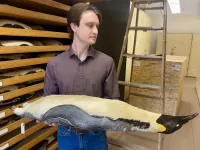(Press-News.org) NORMAN, OKLA. – In an increasingly data-saturated world, computing infrastructure innovations are needed to make sense of new types of information. Richard Veras, a professor in the School of Computer Science at the University of Oklahoma, has received a National Science Foundation Faculty Early Career Development Program (CAREER) award to develop such an innovation by creating more efficient infrastructure for the computation of sparse and irregular data.
Big data – datasets that are challenging to manage using traditional processing tools due to size and complexity, such as social media connections or human interactions for epidemiology research – have increased in availability over the past 20 to 25 years.
“We have more data than we know what to do with, and there are a lot of interesting questions that we want to be able to ask from the data,” said Veras.
But for the past four or five decades, he notes, computers have been built similarly, in a way that favors crunching dense, regular computations. Consequently, the types of algorithms needed to study the questions asked of sparse, irregular datasets are extremely computationally heavy.
“We want to look at data that is different than what we’ve historically been looking at it, and we want to look at it in a different way, too. But hardware has been designed for a specific type of data. The question is how to reconcile these things.” said Veras. “How do we build better software and hardware for the type of data we’re looking at and the type of problems we have?”
To solve this problem, Veras will develop a new coding language, the Graph Structure Descriptor Language, and a software program that takes a high-level representation of a problem described in a coding language afnd translates it into machine code. He will create the language to describe the shape and structure of these irregular data and the infrastructure necessary to translate that language into efficient code.
Veras hopes that the infrastructure he creates will be embedded into the machinery researchers are already using to work with big data.
In connection with this grant, OU will create a new degree concentration in high-performance computing in computer science. Veras is passionate about creating research opportunities for undergraduate students, the types of opportunities that he had that set him on a successful career in research.
The core of the program will grow around a parallel programming course that Veras teaches. He hopes to expand the concept to two additional courses, one theory-based and the other a capstone course. The capstone course will offer students hands-on opportunities to make a difference in the OU research community.
“We’ll solicit problems from across the university and put students on them to do performance engineering to make these applications more efficient for the labs throughout OU,” said Veras.
Though the concentration is in the very early stages, connecting with industry partners and career preparation will be important parts of the program. The goal, says Veras, is more than working with code; it’s getting students jobs.
“By the time you’re in your junior or senior year and decide that research is interesting, you’re late to the game,” said Veras, who started his experience with research as a college freshman. “I’m very much a proponent of making research available to students as early as we can.”
END
University of Oklahoma researcher to create new coding language, computing infrastructure
2025-02-27
ELSE PRESS RELEASES FROM THIS DATE:
NASA’s Hubble provides bird’s-eye view of Andromeda galaxy’s ecosystem
2025-02-27
Located 2.5 million light-years away, the majestic Andromeda galaxy appears to the naked eye as a faint, spindle-shaped object roughly the angular size of the full Moon. What backyard observers don't see is a swarm of nearly three dozen small satellite galaxies circling the Andromeda galaxy, like bees around a hive.
These satellite galaxies represent a rambunctious galactic "ecosystem" that NASA's Hubble Space Telescope is studying in unprecedented detail. This ambitious Hubble Treasury Program used observations from more than a whopping 1,000 Hubble orbits. Hubble's optical stability, clarity, and efficiency ...
New ocelot chip makes strides in quantum computing
2025-02-27
Scientists based at the AWS Center for Quantum Computing on Caltech's campus have made a leap forward in figuring out how to suppress errors in quantum computers, a pesky problem that continues to be the greatest hurdle to building the machines of the future.
Quantum computers, which are based on the seemingly magical properties of the quantum realm, hold promise for use in many different fields, including medicine, materials science, cryptography, and fundamental physics. But while today's quantum computers can be useful for ...
Computing leaders propose measures to combat tech-facilitated intimate partner violence, human trafficking, and child exploitation
2025-02-27
The Association for Computing Machinery’s Technology Policy Council (TPC) has announced the publication of “TechBrief: Technology Policy Can Curb Domestic Violence, Human Trafficking, and Crimes Against Children,” a new issue brief which explains how intimate partner violence, human trafficking, and child exploitation are facilitated by computing technologies. The term “tech abuse” pertains to a wide variety of abuse in this context. The ACM policy experts contend that tech abuse is being addressed inconsistently, ...
Sometimes, when competitors collaborate, everybody wins
2025-02-27
CAMBRIDGE, MA – One large metropolis might have several different train systems, from local intercity lines to commuter trains to longer regional lines.
When designing a system of train tracks, stations, and schedules in this network, should rail operators assume each entity operates independently, seeking only to maximize its own revenue? Or that they fully cooperate all the time with a joint plan, putting their own interest aside?
In the real world, neither assumption is very realistic.
Researchers from MIT and ETH Zurich have developed a new planning ...
EU Flagship project DORIAN GRAY to use pioneering AI and avatar technology to uncover links between cardiovascular disease (CVD) and mild cognitive impairment (MCI) to improve healthy ageing and survi
2025-02-27
Key take-aways:
Mild cognitive impairment (MCI) is a stage of decline in cognitive function greater than normal for a person’s age and education, not severe enough to impair daily function – but it can progress.
Around one third of people with cardiovascular disease (CVD) also have MCI, yet MCI is undiagnosed in 50-80% of these cases.
The central aim of the EU’s DORIAN GRAY project is to untangle this MCI-CVD connection, reduce the burden of disease at older ages and prolong survival.
Brescia, Italy – 27 February 2025 – A major new project, DORIAN GRAY, ...
SHEA encourages rescheduling postponed Advisory Committee on Immunization Practices (ACIP) Meeting
2025-02-27
The Advisory Committee on Immunization Practices (ACIP) plays a crucial role in protecting childhood and adult health by developing vaccination recommendations based on scientific evidence. SHEA encourages timely rescheduling of the ACIP’s meeting that was scheduled for February 2025 to ensure patients and healthcare providers are getting the most up to date recommendations based on the latest scientific evidence review regarding vaccination.
The ACIP’s recommendations are foundational to public health, guiding pediatric and adult vaccine schedules that have significantly reduced the prevalence of highly communicable infectious ...
Study proposes a new theoretical framework for understanding complex higher-order networks
2025-02-27
Filippo Radicchi, professor of Informatics at the Luddy School of Informatics, Computing, and Engineering, co-authored a ground-breaking study that could lead to the development of new AI algorithms and new ways to study brain function.
The study, titled “Topology shapes dynamics of higher-order networks,” and published in Nature Physics, proposed a theoretical framework specifically designed for understanding complex higher-order networks. It could lead to breakthroughs ...
Archaeology: Vesuvian ash cloud turned brain to glass
2025-02-27
A unique dark-coloured organic glass, found inside the skull of an individual who died in Herculaneum during the 79 CE Mount Vesuvius eruption, likely formed when they were killed by a very hot but short-lived ash cloud. The conclusion, from research published in Scientific Reports, is based on an analysis of the physical properties of the glass, thought to comprise the fossilised brain of the individual.
Glass rarely occurs naturally due to the specific conditions required for formation. For a substance to become glass, its liquid form must cool fast ...
When birds lose the ability to fly, their bodies change faster than their feathers
2025-02-27
More than 99% of birds can fly. But that still leaves many species that evolved to be flightless, including penguins, ostriches, and kiwi birds. In a new study in the journal Evolution, researchers compared the feathers and bodies of different species of flightless birds and their closest relatives who can still fly. They were able to determine which features change first when birds evolve to be flightless, versus which traits take more time for evolution to alter. These findings help shed light on the evolution of complex traits that lose their original ...
Genetic switch could help control leaf growth in poor soils
2025-02-27
A new study has identified a genetic circuit in plants that controls individual leaf growth and allows the plants to adapt to their environment. The findings could help the development of more drought-resistant crops.
Scientists from the University of Nottingham’s School of Biosciences investigated the growth of maize leaves in plants cultivated in three different soils containing differential amounts of nutrients and water. They found that microbes colonising plant leaves across these soils influence the growth of the leaves independently of the concentration of nutrients and soil properties. The findings have been published ...





